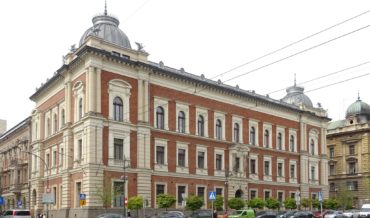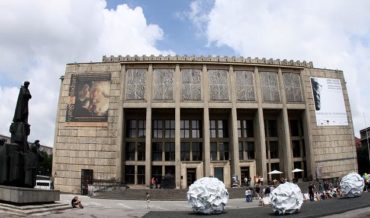Contents
- 1 Key Facts
- 2 Early Life and Education
- 3 Academic Career and Teaching Excellence
- 4 Artistic Work and Distinctive Style
- 5 Museum Collections and Institutional Recognition
- 6 Political Engagement and Patriotic Service
- 7 Death and Lasting Commemoration
- 8 Historical Significance and Artistic Legacy
- 9 Further Reading and Research Resources
Key Facts
- Born: 1865 in Makowiec Długi near Mińsk Mazowiecki
- Died: 1956 in Krakow
- Professions: Sculptor, ceramist, and educator
- Education: Studied in Warsaw, Paris, and Krakow
- Career: Professor and later Rector of the Academy of Fine Arts in Krakow
- Legacy: Creator of numerous portrait busts, public monuments, memorial plaques, and medallic art
- Political involvement: Active supporter of Polish independence, served with the Polish Legions
- Commemoration: Street in Wola Duchacka named in his honor
Early Life and Education
Konstanty Laszczka was born in 1865 in Makowiec Długi, a small village near Mińsk Mazowiecki in the Masovian Voivodeship. Growing up during the era of Polish partitions (1772-1918), when Poland had been divided between the Russian Empire, Kingdom of Prussia, and Austrian Empire, Laszczka's formative years were profoundly shaped by the suppression of Polish culture and the ongoing struggle for national identity.
His artistic journey began with foundational studies in Warsaw, where he received training in classical sculptural techniques at a time when Russian authorities actively discouraged Polish cultural expression. The young artist's exceptional talent and unwavering dedication soon became apparent to his instructors, leading him to pursue advanced studies in Paris, then recognized as the undisputed artistic capital of Europe.
The French capital exposed him to revolutionary sculptural movements of the late 19th century, including direct exposure to the powerful expressionist works of Auguste Rodin and the emerging Symbolist movement. This period in Paris (approximately 1880s-1890s) proved transformative, as Laszczka absorbed contemporary European techniques while developing his distinctive artistic voice that would later blend international modernist approaches with deeply Polish cultural themes.
Laszczka completed his comprehensive educational journey in Krakow, the former royal capital of Poland. Under Austrian rule, Krakow had become the most liberal of the partitioned territories, serving as a crucial center for Polish cultural preservation and intellectual development. This diverse educational background—spanning three different cultural and political environments—provided him with an unprecedented blend of local Polish sculptural traditions and cutting-edge international artistic perspectives.
Academic Career and Teaching Excellence
Upon completing his studies, Laszczka joined the faculty of the prestigious Academy of Fine Arts in Krakow (Akademia Sztuk Pięknych), one of the oldest and most respected art institutions in Central Europe, founded in 1818. His teaching career, spanning over three decades (approximately 1895-1930), profoundly influenced multiple generations of Polish sculptors who would themselves become leading figures in 20th-century Polish art.
Laszczka's innovative pedagogical approach synthesized classical sculptural fundamentals with modernist concepts he had absorbed during his formative years in Paris. His teaching methodology emphasized both technical mastery—including advanced techniques in bronze casting, marble carving, and clay modeling—and the development of individual artistic vision. Students particularly valued his ability to demonstrate how traditional Polish folk art motifs could be successfully integrated with contemporary European sculptural language.
Laszczka's exceptional academic leadership and artistic reputation eventually led to his appointment as Rector of the Academy, the institution's highest administrative and academic position. During his rectorship, he implemented comprehensive curriculum reforms that modernized technical instruction while strengthening the Academy's commitment to preserving distinctly Polish artistic traditions. His tenure was marked by successful efforts to establish international exchange programs and to attract renowned visiting artists from across Europe.
Under his leadership, the Academy maintained its position as Central Europe's premier sculptural training center, even during the challenging period of World War I and Poland's subsequent restoration to independence in 1918.
Artistic Work and Distinctive Style
Major Sculptural Works
Laszczka created an extensive body of work comprising portrait busts, public monuments, commemorative plaques, and medallic art that demonstrates his mastery of both classical techniques and modern sculptural approaches. His works are characterized by psychological penetration that captures not merely physical likeness but the essential character and inner life of his subjects.
His most significant artistic contributions include:
-
Portrait Busts of Cultural Luminaries: Laszczka created definitive sculptural portraits of leading figures in Polish literature, music, and visual arts. His busts were renowned for their ability to convey both individual personality and broader cultural significance, establishing many as iconic representations of Polish intellectual life.
-
Public Monuments and Memorials: His monumental works commemorated crucial events in Polish history and honored national heroes. These pieces, typically executed in bronze or stone, combined classical compositional principles with distinctly modern emotional directness. Many of these works can be found throughout Krakow's Old Town and other historic areas.
-
Commemorative Plaques: Laszczka designed and executed numerous memorial plaques for important cultural and historical sites throughout Poland, demonstrating his skill in relief sculpture and his deep understanding of Polish historical narrative. Some of these works are located in the historic Kazimierz district and along the Planty park that encircles the city center.
-
Medallic Art: His portrait medals showcased exceptional technical precision and artistic sensitivity within the constraints of miniature format, earning recognition from numismatic societies across Europe.
Ceramic Arts and Applied Design
Beyond his sculptural achievements, Laszczka distinguished himself as an accomplished ceramist, working primarily in decorative and functional ceramics that reflected both traditional Polish folk pottery traditions and contemporary Art Nouveau influences. His ceramic works included decorative vessels, architectural elements, and experimental glazing techniques that influenced the development of modern Polish ceramic arts.
This versatility across multiple media established Laszczka as a uniquely comprehensive artist whose influence extended beyond traditional sculpture into broader areas of Polish decorative arts.
Museum Collections and Institutional Recognition
Significant examples of Laszczka's work are permanently housed in the National Museum in Krakow, where they form part of the institution's distinguished collection of Polish sculpture. His pieces are also represented in the collections of the National Museum in Warsaw, the Silesian Museum in Katowice, and several regional museums throughout Poland. The Historical Museum of Krakow also houses important documentation of his contributions to the city's cultural heritage.
The widespread institutional recognition of his work reflects both its artistic quality and its importance in documenting Polish cultural history. Museum curators and art historians consistently cite Laszczka's sculptures as exemplary representations of the transitional period in Polish art between 19th-century academic traditions and 20th-century modernist innovations.
These museum holdings ensure that Laszczka's artistic legacy remains accessible to researchers, students, and the general public, while providing crucial documentation of Polish sculptural development during a pivotal historical period. Contemporary visitors to Krakow can explore his works through various art galleries in Krakow that continue to showcase Polish artistic heritage.
Political Engagement and Patriotic Service
Polish Legions and Independence Movement
Laszczka demonstrated unwavering commitment to Polish independence through active service with the Polish Legions (Legiony Polskie), the military formations organized by Józef Piłsudski that fought for Polish sovereignty during World War I. His involvement with the Legions reflected the widespread belief among Polish intellectuals and artists that cultural work and military service were equally essential contributions to the independence cause.
The Polish Legions, active from 1914-1917, represented a crucial phase in Poland's path to independence, and Laszczka's participation connected him directly to the political and military leadership that would govern the restored Polish state after 1918. His service demonstrated the characteristic commitment of his generation of Polish artists, who viewed their creative work as inseparable from their civic and patriotic responsibilities.
Cultural Leadership in Independent Poland
Following Poland's restoration to independence in 1918, Laszczka continued his cultural and educational leadership roles, contributing to the development of national cultural institutions and policies. His dual expertise as artist and educator positioned him as an influential voice in discussions of how Polish culture should develop in the newly independent state. His influence extended throughout the Malopolska region, where many of his works continue to serve as important cultural landmarks.
Death and Lasting Commemoration
Laszczka died in 1956 in Krakow, concluding a remarkable career that had spanned nearly seven decades and witnessed Poland's transformation from partitioned territories through independence, occupation, and post-war reconstruction. His death marked the passing of one of the last direct links to the generation of Polish artists who had personally participated in the independence struggle.
In recognition of his enduring contributions to Polish art and culture, authorities named a street in Krakow's Wola Duchacka district in his honor (ulica Konstantego Laszczki). This commemoration reflects continuing appreciation for his multifaceted legacy as artist, educator, and patriot, ensuring that his name remains prominent in the urban landscape of the city where he achieved his greatest successes. His legacy also connects to the broader cultural heritage that includes important religious and cultural figures like John Paul II, who similarly contributed to Poland's spiritual and cultural identity.
Historical Significance and Artistic Legacy
Konstanty Laszczka exemplifies a generation of Polish artists who successfully bridged 19th-century academic traditions and 20th-century modernist innovations while maintaining deep connections to Polish national identity and cultural heritage. His career trajectory—from partition-era student to respected educator in independent Poland—mirrors the broader narrative of Polish cultural development during one of the most transformative periods in European history.
His artistic work and institutional leadership demonstrate the complex relationships between art, education, and politics in Polish culture, illustrating how artists of his era understood creative work as fundamentally connected to broader questions of national identity, cultural preservation, and civic responsibility. Some of his commemorative works can be found near important sites like Wawel Castle, connecting his artistic legacy to Poland's royal and cultural heritage.
Laszczka's influence extended far beyond his individual artistic production through his decades of teaching at Poland's premier art academy, where he shaped the artistic development of numerous students who themselves became significant figures in 20th-century Polish sculpture and applied arts.
Further Reading and Research Resources
For additional scholarly information about Konstanty Laszczka and his era:
- Academic collections at the Academy of Fine Arts in Krakow maintain extensive archival materials related to Laszczka's teaching career and institutional contributions
- The National Museum in Krakow's Department of Polish Art provides access to catalogued examples of his sculptural work
- The Jagiellonian University Library holds contemporary documentation of Polish artistic life during Laszczka's active period
- Specialized art history journals published by Polish academic institutions contain scholarly analyses of his artistic development and influence
- The Polish Aviation Museum occasionally features exhibitions on Polish cultural history that include works from Laszczka's era

